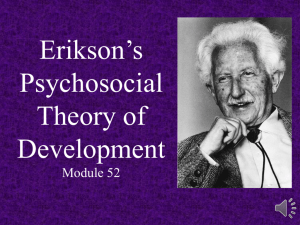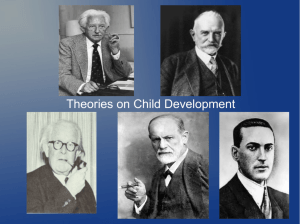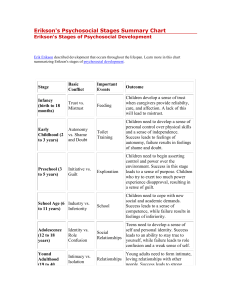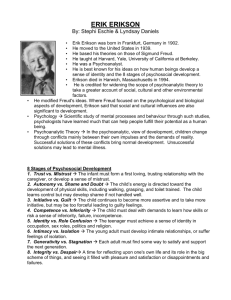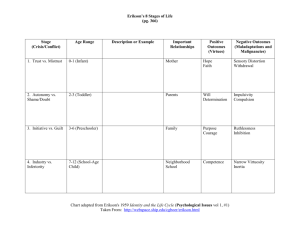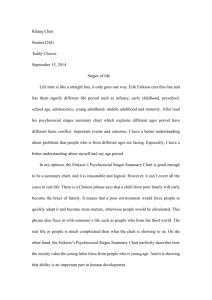Theory: Human Development Theory Theorist: Dr. Erik H. Erikson
advertisement
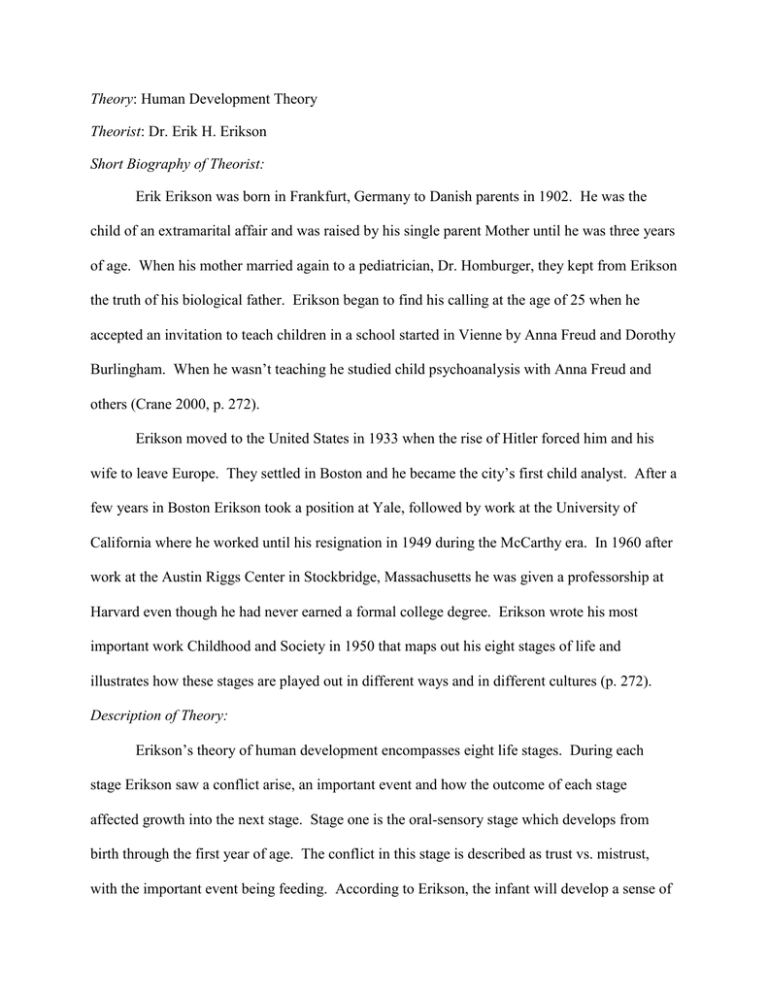
Theory: Human Development Theory Theorist: Dr. Erik H. Erikson Short Biography of Theorist: Erik Erikson was born in Frankfurt, Germany to Danish parents in 1902. He was the child of an extramarital affair and was raised by his single parent Mother until he was three years of age. When his mother married again to a pediatrician, Dr. Homburger, they kept from Erikson the truth of his biological father. Erikson began to find his calling at the age of 25 when he accepted an invitation to teach children in a school started in Vienne by Anna Freud and Dorothy Burlingham. When he wasn’t teaching he studied child psychoanalysis with Anna Freud and others (Crane 2000, p. 272). Erikson moved to the United States in 1933 when the rise of Hitler forced him and his wife to leave Europe. They settled in Boston and he became the city’s first child analyst. After a few years in Boston Erikson took a position at Yale, followed by work at the University of California where he worked until his resignation in 1949 during the McCarthy era. In 1960 after work at the Austin Riggs Center in Stockbridge, Massachusetts he was given a professorship at Harvard even though he had never earned a formal college degree. Erikson wrote his most important work Childhood and Society in 1950 that maps out his eight stages of life and illustrates how these stages are played out in different ways and in different cultures (p. 272). Description of Theory: Erikson’s theory of human development encompasses eight life stages. During each stage Erikson saw a conflict arise, an important event and how the outcome of each stage affected growth into the next stage. Stage one is the oral-sensory stage which develops from birth through the first year of age. The conflict in this stage is described as trust vs. mistrust, with the important event being feeding. According to Erikson, the infant will develop a sense of trust only if the parent or caregiver is responsive and consistent with the basic needs being meet. The need for care and food must be met with regularity. The infant must first form a trusting relationship with the parent or caregiver, failure results in a sense of mistrust (p. 273). Stage two is the muscular-anal stage which develops in early childhood from ages 2 through 3. This conflict is autonomy vs. shame and doubt, with the important event being toilet training. Erikson theorized that children need to develop a sense of control over physical skills and a sense of independence. Success leads to feelings of autonomy, failure results in feelings of shame and doubt (p. 274). Stage three is the locomotor stage which develops between the ages of three and six. The conflict during this time is initiative vs. guilt, with the important event being gaining independence. A child will develop a sense of independence and exploration as they take more initiative and begin to exert some power and control of situations. As the child exerts too much power and control they meet with disapproval that leads to feelings of guilt (p. 274). Stage four is the latency stage which develops between the ages of six and 12. The conflict is industry vs. inferiority, with the important event being school and education. As the child grows and develops through peer interaction outside the home during school a sense of pleasure comes from being productive and building a larger social group. A sense of failure occurs when the transition from home to school is not positive and it will lead to the child feeling inferiority when compared to others of their age group (p. 275). Stage five is adolescence which develops between the ages of 12 and 18. The conflict is identity vs. role confusion, the important event occurs around social/peer relationships. As the child becomes a teenager they want to answer the question of who they are and what they believe to be true. This stage builds on the social growth that has occurred in the two previous stages. Success is staying true to who you are as a teenager during this stage while failure can be seen in a confusion of roles and a weak sense of self (p. 276). Stage six is young adulthood which develops between the ages of 19 to 40. The conflict is intimacy vs. isolation, the important event during this stage is intimate relationships. This stage relies on the person understanding their own sense of self and identity. There is a need to form intimate relationships with other people by relating in a personal way to another individual. Without a sense of self and the ability to relate to another person a feeling of isolation and loneliness can overcome the individual (p. 277). Stage seven is middle adulthood which develops between the ages of 40 and 65. The conflict is generativity vs. stagnation; the important events are work and parenting. Adults need to create or nurture things that will outlast them, often by having children or creating a positive change that benefits other people. Success leads to feelings of usefulness and accomplishment, while failure results in stagnation and a shallow involvement in the world (p. 278). Stage eight is late adulthood/maturity which is characterized between the ages of 65 to death. The conflict is integrity vs. despair; the important events are reflection on and acceptance of life. Older adults need to look back on their lives with a sense of accomplishment and acceptance which leads to a sense of integrity and helps to cope with death. Without this integrity an older adult can feel bitterness and regret as they fear death (p. 280). Theory Measurement/Instrumentation: Erikson’s integral theory has not been researched empirically very much. There are two reasons for this lack. First, researching Erikson’s theory requires a complex and very costly apparatus. Investigators need longitudinal studies that trace people from birth to death, so that each phase can be measured and followed. This is the only way to investigate whether each phase does indeed influence development. Due to the expense of such research it is probable that an assumption can be made to the lack of this empirical research. Second, some research has been inspired by Erikson’s theory, however, they have tended to focus primarily on phase 5, identity formation, because reliable empirical instruments have been developed to chart identity formation not specifically related to Erikson’s (Meeus, 1996, p. 88). Report prepared by: Barbara A. Abercrombie References: Crane, William C., Theories of Development: Concepts and Applications, 2000, Prentice Hall, Upper Saddle River, N.J., 4th edition. Hurrelmann, Klaus & Hamilton, Stephen F., Social Problems and Social Contexts in Adolescents 1996, Aldine De Gruyter, New York: Chapter 4, Meeus, Wim; Toward a Psychosocial Analysis of Adolescent Identity: An evaluation of the Epigenetic Theory (Erikson) and the Identity Status Model (Marcia).

